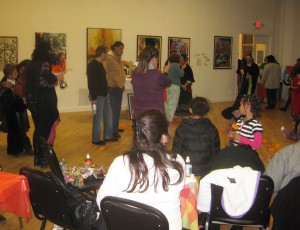
https://vimeo.com/31760505]

The sight of an altar honoring people who have passed away and marigolds being placed around it can be an odd sight next to face painting, costumes, candy and other elements more typically associated with Halloween. But then again, that was the point.
Raices Culturales Latinoamericanas, located at 1417 N. Second St., used its monthly Tertulia to demonstrate to local children the differences between the American holiday of Halloween and the Latino holiday of the Day of the Dead.
“The children who live in this country who have family and parents from Latino countries are losing the traditions from the Hispanic countries,” said Concha Alborg, the president of the board of directors for Raices Culturales Latinoamericanas. “They know Halloween, they dress up, but they forget what Dia de los Muertos [Day of the Dead] is.”
The Tertulia, which is held on the fourth Friday of each month, is usually an event intended for those 15 years old and older and features a guest speaker who lectures about a topic relevant to some Latin American culture. Esther Recio, one of the Tertulia committee members, said that throughout the year the group tries to feature topics relevant to as many Spanish-speaking countries as possible.
In addition to the speakers, there is also an open microphone time during the Tertulia when anyone can get up and share a song, dance or a poem.
But the Tertulia is only one small part which the organization uses to accomplish its goal of spreading and sharing Latin American culture with the community.

“Seventy percent of the Latinos in Philadelphia are Puerto Rican, so Raices was founded 20 years ago to represent the non-Puerto Rican groups that wanted to preserve their culture,” said Veronica Perez, the executive director of Raices Culturales Latinoamericanas.
The Latin American population is one that has a growing presence in Philadelphia. According to U.S. census data, from 2000 to 2010, the Latino population in Philadelphia grew from 128,928 to 187,698 which represents about a 45 percent increase. Also, Latinos now represent 12.3 percent of the population in Philadelphia, up from 8.5 percent in 2000.
In addition to the Tertulia, Raices serves this population by holding music, dance and art class, putting on performances in the Philadelphia area and making their dance studio available for groups to rent out and use.
“We have a roster of over 150 artists from different countries and most of our earned income comes from finding these artists work,” Perez said. “These are people with full-time jobs but they want to preserve their homeland.”
On a weekly basis though, Raices holds classes on various forms of Latino dance and music. These classes are open to anyone interested and contain all sorts of age ranges.
Among these classes are beginner and intermediate flamenco dance on Saturdays, hip hop and ballet on Mondays and Tuesdays and a jam session which is free and open to the public on Sunday afternoons.
These classes are held in Raices’ dance studio, which is also rented out to other groups to use to practice and or put on classes and workshops of their own.
One such group call Timbalona uses the studio to hold workshops on Afro-Cuban music, primarily focusing on “the history and roots of salsa music,” said Andres Cisnelos, the percussionist for Timbalona.

The opportunity to use Raices’ studio is one that the members of Timbalona don’t undervalue. “The great thing about Raices is that they have this dance space and other spaces that are available to the community to rent out and hold activities,” Cisnelos said. “This is one of the options we have in this growing number of artistic expressions that is being led in the city.”
Raices just recently moved to its current location in July after spending its first 20 years along El Centro De Oro at 2757 N. Fifth St. One of the main reasons, Perez said, was accessibility, citing that the old location didn’t allow easy access for people with disabilities. So in essence, the move was made to spread and increase the impact the organization has on the community.
“Through education it [Raices] benefits the local community,” said Jacquelyn Crutchley, an intern for Raices. “When you learn about another culture it extinguishes some of the hate and stereotypes that people have and then you can teach other people about it.”


Esther Recio was my old Spanish teacher at St. Joe’s before I transferred to Temple. I love her. She is great! I’m not surprised that she’s involved in an organization like this.
Good for her and good for the organization!
I audited a Southern literature class at SJU, and Esther Recio was my classmate. Such warmth and enthusiasm! Now we both teach at St. Joe’s.
I like what Fairhill is doing and I am adding it to the list of organizations I prefer to receive Christmas gifts in my stead.
Feliz Navidad!
It’s invaluable work that you have set in the musical field. Nothing to describe, discuss, report and leave a legacy, like music, of which very few are concerned, especially as in this case where there is much that we must invest :: love, time, talent, logistics, knowledge, patience, and you stop counting.
I want all that energy that you bring to multiply to attract more members and collaborators in all forms to materialize all suen’os.